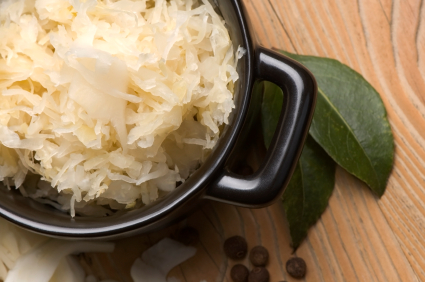I have fallen in love with the ease in making fermented foods. If you have salt (preferably sea salt), then you can ferment food.
Before the days of electricity and canning, this was the way that food was stored for the long term. This is also one of the simplest methods of home preservation – there is no need for hot water bath canning. There is no energy usage (aside from your own work) required, something that may one day be very important.
There are many health benefits from fermenting your food. Fermentation creates lactic acid, nature’s preservative. This promotes the growth of healthy bacteria in the human intestines. Other benefits to fermentation are:
- Increased digestibility: proteins are broken down and enzymes are replenished
- Increased nutritional value: vitamins B and C are produced in abundance by the presence of yeast in the process
- Increased probiotic bacteria (lactobacillis)
The best aspect about fermentation is that it is the only method of preservation that actually adds nutrition to the stored food. Fermented food is live food loaded with probiotics and healthy enzymes.
Other vegetables can also be preserved in this manner. Choose as many herbs and spice as you’d like: dill, whole peppercorns, caraway seeds, basil, tarragon, bay leaves, dried chili peppers
Old-fashioned Sauerkraut
Ingredients:
- 1 large head of cabbage (any color cabbage is fine)
- 2 tbsp. of sea salt (stick with the more nutritious forms of salt so your sauerkraut is healthier)
- 1 tbsp. caraway seeds
- Optional: 1 shredded apple and 1 shredded onion
Note: You will need a large glass bowl or crock for this.
Instructions:
- Peel the first two leaves of the cabbage head off and set aside for later.
- Shred the cabbage, either by hand or in a food processor.
- Place the cabbage in a large bowl, add the salt and (seeds) and allow cabbage to sit out for 1-2 hours at room temperature. Tip: After 1-2 hours, the cabbage will look wilted. Allowing the cabbage to rest allows the salt and caraway seeds to naturally draw out the moisture of the cabbage.
- Begin massaging or use a potato masher on the cabbage and press it down, working the salt in with your hands. The liquid from the cabbage will release. There should be a good amount water from the cabbage in the bowl.
- If using, add your apple, onion or additional vegetables and mix well.
- Spoon the mixture into 1-quart canning jars, leaving at least 1 inch of head space. Tip: 1-inch of head space allows the oxygen from the fermentation process to escape into the jar.
- The cabbage should be completely covered by liquid. If there is not enough liquid add filtered water to each jar until it is covered. Depending on size of bowl or jar that sauerkraut is fermenting in, cover with reserved cabbage leaves. This method works best if using quart canning jars. if your bowl or jar is larger, use a plate with a weight on top.
- Allow jars to sit out at room temperature for 3-5 days to get fermentation process going. Begin taste-testing and halt the process when it has reached the flavor you like. The fermentation process could take up to 2-4 weeks.
- After 5 days of fermenting at room temperature, sauerkraut can be moved to the refrigerator to slow the fermentation process.
Tip: The brine from sauerkraut can be reserved for future kraut recipes.
If you choose to can your sauerkraut, follow steps 1-5. Next, in a large pan, bring sauerkraut to a simmer (185 to 210 degrees F). Do not boil. Pack hot cabbage into hot jars, leaving 1/2 inch headspace. Remove air bubbles. Adjust caps. Process pints 15 minutes, quarts 20 minutes, in a boiling water canner.
Sauerkraut cannot get any simpler than this folks! It’s cheap and is packed full of health benefits. Learning how to ferment foods will keep you healthier during a short-term or an extended emergency.






Two questions:
1. Can the cabbage be safely left out for 2-5 days or up to 2-4 weeks then be heated and jarred?
2. After following canning steps 1-5, can the bottled jars be placed in an oven instead of boiling?
Please reply and thank you.